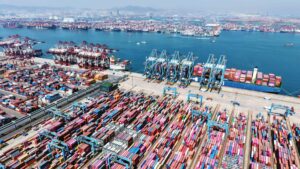Russian energy giant Gazprom’s average daily natural gas supplies to Europe via the TurkStream undersea pipeline increased by 10.3% in May from a month earlier, calculations showed on Monday.
Türkiye is the only transit route left for Russian gas to Europe after Ukraine chose not to extend a five-year transit deal with Moscow when it expired on January 1.
Russian gas exports via the TurkStream pipeline rose to 46 million cubic metres (mcm) per day in May from 41.7 mcm per day in April, according to Reuters calculations based on data from European gas transmission group Entsog.
That was down from 47.2 mcm in May 2024.
Total Russian gas supplies to Europe via TurkStream stood at around 7.2 billion cubic metres (bcm) in the first five months of this year, compared to 6.6 bcm during the same period a year earlier, according to the calculations.
The company, which has not published its own monthly statistics since the start of 2023, did not respond to a request for comment.
TurkStream runs for 930 kilometers (580 miles) under the Black Sea from the Russian resort city of Anapa to Kıyıköy in northwestern Türkiye. It then connects to overground pipelines that run up through the Balkans to western Europe.
It has an annual capacity of 31.5 billion cubic meters. About 15.75 bcm is designated for supplies to Türkiye’s domestic customers, and the rest is earmarked for European countries.
The 27-member European Union has been reducing its dependence on Russian gas since Moscow launched its invasion of Ukraine in February 2022. But several European countries have increased their purchases of Russian liquefied natural gas (LNG), which is transported by sea.
Russia supplied about 63.8 bcm of gas to Europe by various routes in 2022, Gazprom data and Reuters calculations show. That plummeted by 55.6% to 28.3 bcm in 2023, but increased to around 32 bcm in 2024.
At their peak in 2018-2019, annual gas flows to Europe reached between 175 bcm and 180 bcm.
Russia also used to ship gas to Germany via the Nord Stream 1 pipeline, which runs under the Baltic Sea. In 2022, a sabotage attack also hit one of the two Nord Stream 2 pipelines, a second undersea gas link between Russia and Germany that was never put into operation.




















































Be First to Comment